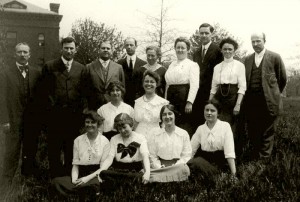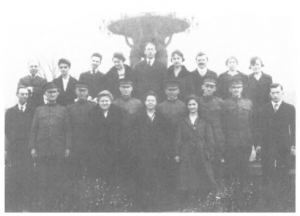What Happened to the Women Computers?

I’ve spoken about the Dudley Observatory’s corps of women computers several times now. Every time, someone has come up to me afterwards to mention that, back in their day, there still were departments of women working low level mathematical jobs. Without giving away anyone’s age, I can say this runs up until the seventies.
This makes sense. Although the job would change, the fundamental forces that creating the teams of women computers would stay the same: the job was tedious, time consuming and low status, making it suitable women’s work in a time of nearly unquestioned gender roles. And women could be hired in greater numbers because they could be paid less, allowing large teams to be created.
And there’s no reason that it should be confined to the field of astronomy. The factory model of doing mathematical equations seems to have been born in astronomy, but it was too useful to stay there.
One field where number crunchers were in great demand was ballistics. During WWI, the militaries of the world realized that the equations for cannon trajectories did not work for modern anti-aircraft guns and bombs dropped from zeppelins. And so a proving ground for modern weapons was set up in Aberdeen, Maryland, and an office of experimental ballistics was set up in Washington under Major Forest Ray Moulton.

In civilian life, Moulton had been a professor of astronomy at the University of Chicago. This worked well, because the equations for the flight of artillery shells used some of the same calculus as plotting the path of a comet. And when Moulton went looking for computers, he used the same process used in astronomy and began hiring both men and women. His chief computer was Elizabeth Webb Wilson, a graduate of George Washington University with a degree in mathematics.
About the time that Dudley was completing its massive star catalog, Virginia Tucker was being hired by Langley Memorial Aeronautical Laboratory to work in a new computer pool. From 1935 until 1946, Tucker would help calculate drag from wind tunnel tests (another factor in ballistics) in what would eventually become America’s space program. By the end of WWII, Tucker was overseeing some 400 women computers working throughout the laboratory.

The idea of women computers persisted, even as the equipment went from being pencil-and-paper to adding machines to punch cards. Eventually the title of “computer” was transferred to the device and the human operator became a programmer. But the same forces still applied, and so the first programmers were women.
Betty Jennings and Frances Bilas setting up ENIAC
For example, during WWII the Aberdeen Proving Grounds went to work again, this time with 80 women employed at the University of Pennsylvania to calculate ballistic trajectories. In 1945, six of these women were tapped to program a new device known as the Electronic Numerical Integrator And Computer or ENIAC. ENIAC is regarded as the world’s first electronic digital computer, making these six women the first programmers in the modern sense.
So there is a direct line between the crews of female computers in observatories like Dudley and the early days of programming. This story of women’s key role in the trenches of mathematics and programming is a story that is just now being told. I would recommend David Alan Grier’s book When Computers Were Human for an overview, and the new documentary “The Computers: The Remarkable Story of the ENIAC Programmers” for that chapter of the story. Of course, that’s not the final chapter by any means, but the rest will have to wait for another post.
